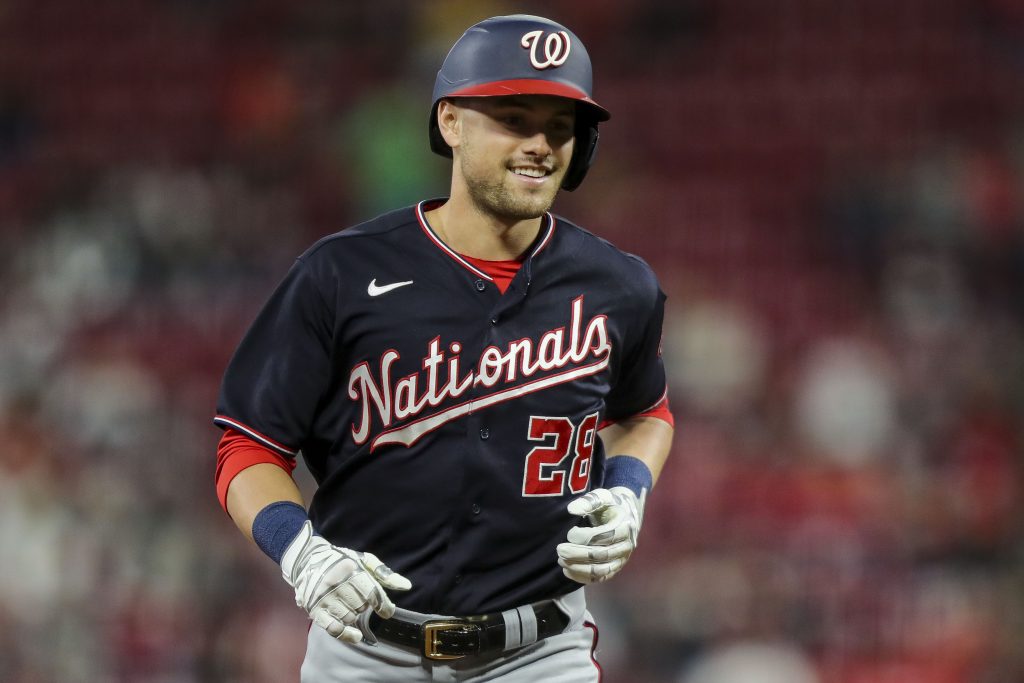
The Nationals had a high-profile teardown this past July. The biggest splash sent Max Scherzer and Trea Turner to the Dodgers, while other notables like Kyle Schwarber, Yan Gomes and Daniel Hudson were flipped to contenders. Almost buried amidst that flurry was a lower-profile swap announced less than an hour before the deadline: acquiring outfielder Lane Thomas from the Cardinals for veteran starter Jon Lester. While that trade didn’t grab nearly as many headlines as some of the Nats’ other moves, the early returns look very promising.
Thomas has been around for a few seasons, but he never got an extended look with St. Louis. Between 2019-21, he struggled to a .172/.289/.336 line across 142 scattered plate appearances. Generally regarded by prospect evaluators as a fourth outfield type and turning 26 years old in August, it’s easy to understand why the Cardinals’ front office was willing to make him available. Yet Thomas picked up everyday run on a depleted Washington roster down the stretch, putting up quietly excellent numbers.
Over 206 plate appearances in the nation’s capital, the former fifth-round pick posted a .270/.364/.489 slash line, hitting seven home runs and stealing four bases. He spent the bulk of that time in center field, playing well enough to supplant former top prospect Víctor Robles on the depth chart. That offensive output was 27 percentage points above the league average, by measure of wRC+. More encouragingly, it was largely backed up by strong plate discipline and batted ball metrics.
During his end-of-season run, Thomas demonstrated an enviable combination of patience, bat-to-ball skills and power on contact. The right-handed hitter had an extreme willingness to work deep counts, a continuation of a trend he’d shown in St. Louis. Thomas swings far less often than most at pitches both inside and outside the strike zone, a plan of attack that allows him to draw plenty of walks but also puts him at risk for his share of strikeouts. Yet he kept the punch outs manageable during his time in Washington by making contact on a robust 82.4% of his swings (about six percentage points higher than the league mark).
That patience and contact frequency gave Thomas a strong floor from an on-base perspective, but his contact authority was particularly impressive. The Tennessee native had an average exit velocity of 91.7 MPH, more than three ticks harder than the 88.1 MPH league average. According to FanGraphs, he made hard contact on 45.1% of his batted balls with the Nats. The average MLB hitter (excluding pitchers) had a 32.5% hard contact rate in 2021.
That’s a rare set of skills, even in a limited sample of work. Among the 463 players with at least 100 plate appearances, only sixteen managed a hard contact rate north of 40% while striking out in fewer than a quarter of their trips to the dish. Other than Thomas, every player in that group posted a wRC+ of 122 or higher (indicating they were at least 22 percentage points more productive than average offensively). Removing Thomas’ poor 58 plate appearances with the Cardinals early in the season puts him right among that very impressive list of names, both from a results and process perspective.
That’s not to say Thomas is absolutely an elite hitter now, or even that the Cardinals made a mistake in giving him up. Lester was a reliable source of decent innings down the stretch, helping St. Louis to a fantastic second-half run to the postseason. And Thomas needs more than two months of strong performance to cement himself as a core member of the Nats’ future.
His first couple months in a Washington uniform couldn’t have gone much better, though. At the very least, he’s earned an extended opportunity to try to cement himself alongside Juan Soto in the long-term outfield. The Nationals are likely to take a step back in 2022 as they audition younger players like Thomas, but they prioritized near-MLB returns during their deadline sell-off and aren’t about to embark on a rebuild while Soto is under club control. Washington may need some things to fall into place to be realistic contenders in what should be a competitive NL East by 2023. Thomas settling in as a productive regular would be one those pluses, and he’s started off on the right foot with his new club.
Image courtesy of USA Today Sports.
Credit : Source link






